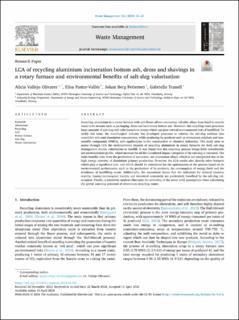| dc.contributor.author | Vallejo Olivares, Alicia | |
| dc.contributor.author | Vallés, Elisa Pastor | |
| dc.contributor.author | Pettersen, Johan Berg | |
| dc.contributor.author | Tranell, Maria Gabriella | |
| dc.date.accessioned | 2024-04-24T08:20:38Z | |
| dc.date.available | 2024-04-24T08:20:38Z | |
| dc.date.created | 2024-04-16T21:25:26Z | |
| dc.date.issued | 2024 | |
| dc.identifier.citation | Waste Management. 2024, 182 11-20. | en_US |
| dc.identifier.issn | 0956-053X | |
| dc.identifier.uri | https://hdl.handle.net/11250/3127864 | |
| dc.description.abstract | Recycling aluminium in a rotary furnace with salt-fluxes allows recovering valuable alloys from hard-to-recycle waste/side-streams such as packaging, dross and incinerator bottom ash. However, this recycling route generates large amounts of salt-slag/salt-cake hazardous wastes which can pose critical environmental risks if landfilled. To tackle this issue, the metallurgical industry has developed processes to valorise the salt-slag residues into recyclable salts and aluminium concentrates, while producing by-products such as ammonium sulphate and non-metallic compounds (NMCs), with applications in the construction or chemical industries. This study aims to assess through LCA the environmental impacts of recycling aluminium in rotary furnaces for both salt-slag management routes: valorisation or landfill. It was found that this recycling process brings forth considerable net environmental profits, which increase for all the considered impact categories if the salt-slag is valorised. The main benefits arise from the production of secondary cast aluminium alloys, which is not unexpected due to the high energy intensity of aluminium primary production. However, the LCA results also identify other hotspots which play a significant role, and which should be considered for the optimisation of the process based on its environmental performance, such as the production of by-products, the consumption of energy/fuels and the avoidance of landfilling waste. Additionally, the assessment shows that the indicators for mineral resource scarcity, human carcinogenic toxicity and terrestrial ecotoxicity are particularly benefited by the salt-slag valorisation. Finally, a sensitivity analysis illustrates the criticality of the metal yield assumptions when calculating the global warming potential of aluminium recycling routes. | en_US |
| dc.language.iso | eng | en_US |
| dc.publisher | Elsevier | en_US |
| dc.relation.uri | https://authors.elsevier.com/sd/article/S0956-053X(24)00239-3 | |
| dc.rights | Navngivelse 4.0 Internasjonal | * |
| dc.rights.uri | http://creativecommons.org/licenses/by/4.0/deed.no | * |
| dc.title | LCA of recycling aluminium incineration bottom ash, dross and shavings in a rotary furnace and environmental benefits of salt-slag valorisation | en_US |
| dc.title.alternative | LCA of recycling aluminium incineration bottom ash, dross and shavings in a rotary furnace and environmental benefits of salt-slag valorisation | en_US |
| dc.type | Peer reviewed | en_US |
| dc.type | Journal article | en_US |
| dc.description.version | publishedVersion | en_US |
| dc.source.pagenumber | 11-20 | en_US |
| dc.source.volume | 182 | en_US |
| dc.source.journal | Waste Management | en_US |
| dc.identifier.doi | 10.1016/j.wasman.2024.04.023 | |
| dc.identifier.cristin | 2262176 | |
| dc.relation.project | Norges forskningsråd: 296276 | en_US |
| dc.relation.project | EU – Horisont Europa (EC/HEU): 869268 | en_US |
| cristin.ispublished | true | |
| cristin.fulltext | original | |
| cristin.qualitycode | 1 | |

